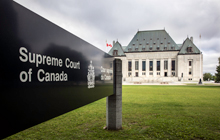The latest Canadian tax scam has a Caribbean flavour

Allan Lanthier looks at the BVI Switch tax avoidance scheme used by wealthy Canadians and what action could be taken by the federal finance minister
 |
Allan Lanthier is a retired partner of an international accounting firm, and has been an advisor to both the Department of Finance and the Canada Revenue Agency. |
Montreal – There’s a new Canadian tax scam making the rounds, and this one has a distinctly Caribbean flavour. Wealthy Canadians are taking advantage of Canadian private corporations,[1] and tax havens such as the British Virgin Islands, to slash their tax bills on capital gains. The Canada Revenue Agency (CRA) is challenging the scheme under the general anti-avoidance rule (GAAR), and a small number of files are already sitting with the Tax Court of Canada awaiting trial. There will be many more appeals: hundreds of millions of tax dollars are at stake.
This article discusses the taxation of “Canadian-controlled private corporations” (CCPCs)[2] under the Act, and how the tax rules for CCPCs differ from those governing non-CCPC private corporations. After describing the tax scam, I comment on (a) whether the scheme may be abusive under the GAAR, and (b) actions that the government should be taking at this time.
The taxation of CCPCs
There are a great number of favourable tax rules that apply to CCPCs. For example, a CCPC benefits from rock-bottom tax rates on its first $500,000 of annual business income,[3] as well as a 35 per cent credit for research and development expenses.[4] In addition, an individual who sells shares of a CCPC may be eligible for a lifetime capital gains exemption of $913,630 (indexed amount for 2022).[5]
On the other hand, to prevent a CCPC from being used as a personal savings account by its shareholders, the CCPC rate on most investment income, including the taxable half of capital gains, is about 50.2 percent rather than the general rate of 26.5 percent.[6] The 50.2 percent rate includes 30.67 percent that is refundable to the CCPC when it pays taxable dividends to its shareholders. The following table illustrates the corporate and personal tax that applies if a corporation earns $1,000 of investment income and pays the after-tax amount to an individual in the top personal tax bracket in Ontario:
|
|
CCPC |
NON-CCPC |
|
A. Investment income |
1,000.00 |
1,000.00 |
|
B. Corporate tax |
501.70 |
265.00 |
|
C. Net amount (A-B) |
498.30 |
735.00 |
|
D. Portion of corporate tax that is refundable |
306.70 |
N/A |
|
E. Amount of dividend (C+D) |
805.00 |
735.00 |
|
F. Personal tax on dividend at 47.74% (CCPC) or 39.34% (Non-CCPC) |
384.30 |
289.15 |
|
Combined corporate and personal tax (B-D+F) |
579.30 |
554.15 |
As can be seen, these “integration” rules are far from perfect. The federal-provincial rate for an individual resident in Ontario in the highest tax bracket is 53.53 percent, but the combined corporate-personal tax if investment income is earned by a corporation and then paid as a taxable dividend is 57.93 percent (CCPC) or 55.42 percent (non-CCPC).[7]
The distinction between CCPCs and non-CCPCs
The distinction under the 1971 tax reform bill was between private and public corporations, not CCPCs and non-CCPCs.
A portion of tax paid by private corporations on investment income was added to the refundable dividend tax on hand (RDTOH) account. In addition, private corporations were subject to a separate refundable tax on dividend income under Part IV of the Act, and had access to the capital dividend account for the non-taxable half of capital gains. None of these rules applied to public corporations. The only special tax rate that applied to CCPCs was the low business rate on the first $50,000 of annual active business income.[8]
These rules began changing in 1981. Under Bill C-139,[9] for years commencing after November 12, 1981, RDTOH for Part I tax on investment income was restricted to CCPCs. There was little reaction to this change at the time, perhaps because it did not involve any new or additional taxes. This would change.
In 1995, section 123.3 of the Act introduced a 6.67 percent refundable tax on a CCPC’s investment income, a rate that was later increased to 10.67 percent. This new tax was required to keep the corporate tax rate on investment income in the range of personal tax rates. Consistent with the November 1981 amendments, the tax applied to CCPCs, but not to other private corporations.
Then, in 2000, corporate tax rate reductions were introduced under section 123.4 of the Act, but only for “business income not currently eligible for special tax treatment”: as a result, the tax rate reduction — which is now 13 per cent — did not apply to investment income earned by CCPCs.
In short, a tax benefit for qualifying as a CCPC became a tax liability. Until 1995, a CCPC’s investment income was taxed at the same general corporate tax rate as income earned by any other corporation, but the CCPC benefited from the fact that a portion of the tax was refundable. However, with the additional refundable tax under section 123.3 and the denial of the general rate reduction under section 123.4, a CCPC now faces tax of 23.67 per cent on investment income that a non-CCPC does not.
The BVI switch
Having regard to the additional tax of 23.67 per cent that now applies, wouldn’t it be terrific if a CCPC that is about to realize a sizable capital gain could magically become a non-CCPC and pay tax at the rate of only 26.5 per cent? Well, look no further than the British Virgin Islands (BVI).
As noted earlier,[10] a CCPC generally means a private corporation that is incorporated in Canada. So here’s the scheme. Under the “continuance” provisions of corporate law, the CCPC changes its governing law from Canada to the BVI.[11] As the company is no longer “incorporated in Canada”,[12] it ceases to be a CCPC. However, if it maintains central management and control in Canada, it will still be a Canadian tax resident, subject to the tax rules for non-CCPCs.
There are at least four CCPC avoidance files sitting with the tax court. Three of these files involved a switch to BVI corporate law.[13] The fourth is a variation on the same theme: shortly before disposing of an investment asset and realizing a substantial capital gain, the CCPC issued voting, redeemable preferred shares to three non-resident family members that gave the non-residents 50.89 percent of the votes.[14]
The combined tax in dispute in the four files is about $17 million. The CRA’s position is that the GAAR applies.[15] The taxpayers argue that, even if the only purpose of the BVI switch[16] was to avoid tax, the switch was not “abusive”. And so now we await the decisions of the court.
Doesn’t the BVI switch result in a deferral of tax, not a permanent savings?
It is true that, if a non-CCPC avoids tax using the BVI switch, the individual shareholders should still face tax in future when the after-tax income is paid to them as taxable dividends.
While the scheme therefore only results in a deferral, the deferral may last for many years. Also, during that period, the corporation may be able to sprinkle dividends to family members who are in lower tax rate brackets.[17] Second, dividends paid by a non-CCPC will generally be “eligible dividends” under the Act, resulting in a lower personal tax cost. Finally, if dividends are not paid until after the shareholder’s death, the deferred amounts might only be taxed at capital gains rates.[18]
Who will prevail — the Minister or the taxpayer?
It seems to me that a coin flip may be in order. Certainly, the sole purpose of the BVI switch is the avoidance of Canadian tax. However, if the Minister is to prevail, she must go further, and demonstrate that the transaction misuses sections 123.3 and 123.4 of the Act, or is an abuse of the Act read as a whole.
In submissions filed with the tax court, the Minister is taking the position that the general scheme of the Act is to prevent tax deferral where a private corporation controlled by residents of Canada earns investment income, and that a deliberate flip out of the CCPC rules to avoid tax frustrates and defeats the rationale underpinning sections 123.3 and 123.4. To prevail, the Minister may have to convince the court that the object and spirit of those provisions are not fully reflected in their text.[19] The fact that an election to be a public corporation requires, in part, that the corporation’s shares be widely-held, may lend some support to the Minister’s position.[20]
The taxpayers take a different view. “There is no broad or overarching policy in the Act that provides for integration,” states one of the appeals. In 1981, RDTOH was restricted to CCPCs, and the link to non-CCPCs was intentionally broken. The Part IV refundable tax on dividend income continued to apply to all private corporations.[21] And in 2017, the government acknowledged that non-CCPC private corporations were not subject to the refundable tax regime:[22] the government stated it would consider changing the rules, but never did.
In short, it is not clear who will prevail. As always, if it is the tax avoiders, you and I will bear the cost. And the cost will be substantial. The $17 million in dispute at this time is only the tip of the iceberg. Tax advisors have been flogging this plan, and taxpayer appeals are only starting to trickle in.
What should the government do?
There is a clear risk that taxpayers will prevail in transactions involving the BVI switch — transactions carried out for the sole purpose of avoiding tax. Should the government take action, or simply wait to see what the tax court decides? I believe that action should be taken on two fronts now.
First, the GAAR should be strengthened. In November 2020, Finance Minister Chrystia Freeland said she would launch consultations to modernize the GAAR to better address sophisticated and aggressive tax planning,[23] a promise that was repeated in one sentence of the 725-page federal budget in April 2021. It has been more than a year since the announcement was made, and the silence from Ottawa has been deafening.
The Minister should consider amending the GAAR so that any transaction or series of transactions whose dominant purpose is the avoidance of tax is struck down, without giving taxpayers an exit ramp based on the fuzzy notion of “abuse”. The tax establishment will mobilize and lobby of course, claiming that such a rule would shut down ordinary-course tax planning. Nonsense. Tax benefits would not be denied if the benefits arose as part of bona fide planning that was not predominantly tax motivated. A less controversial approach might be to leave the abuse exception in place, but require that the taxpayer demonstrate that there has been no abuse, rather than leaving the onus on the Minister.[24]
Second, the Minister should take specific action to shut down the BVI switch. For example, Ms. Freeland could announce today that, when Parliament returns from recess later this month, she intends to table legislation that will put an end to these shenanigans. The new rules would apply on the day the announcement is made. The most simple and effective change would be to deny the capital dividend account to private corporations that are not CCPCs.
Unless or until the Minister decides to act, taxpayers who are considering this scheme should at least be on notice that the CRA GAAR Committee has decided that these transactions should be challenged and reassessed.
Footnotes
[1] The term “private corporation” is defined in subsection 89(1) of the federal Income Tax Act: RSC 1985, c. 1 (5th Supp.), as amended (referred to in this article as the “Act”). In general terms, a corporation is a “private corporation” if it is resident in Canada, is not a public corporation, and is not controlled by one or more public corporations.
[2] A CCPC is defined in subsection 125(7) of the Act to mean, in general terms, a private corporation that is incorporated in Canada, other than a corporation that is controlled, directly or indirectly, by one or more non-resident persons, by one or public corporations, or by any combination of them.
[3] The $500,000 annual limit applies to an associated group of CCPCs. The preferential rate is phased out and recovered if taxable capital is between $10 and $15 million, or if passive investment income is between $50,000 and $150,000 in the preceding year.
[4] Subject to a number of tests and restrictions, the 35 percent rate applies to a CCPC’s qualified expenditures of up to $3 million a year.
[5] Beyond these measures, a CCPC enjoys a number of additional benefits, including: an employee stock option deferral; an extended balance-due date; a shorter normal reassessment period of three years; and entitlement of its shareholders to allowable business investment losses.
[6] The rates used in this article include the Ontario provincial corporate tax rate of 11.5 percent. In 2021, the provincial and territorial rates ranged from 8 percent in Alberta to 16 percent in Prince Edward Island.
[7] The personal tax rate will generally be the non-eligible dividend rate for dividends received from a CCPC or, in the case of a non-CCPC, the lower rate for eligible dividends.
[8] An annual limit that was later increased.
[9] Bill C-139 was tabled in the House of Commons on December 7, 1982.
[10] Supra, footnote 2.
[11] While jurisdictions such as the Cayman Islands can be used instead of the BVI, the BVI seems to be the jurisdiction of choice. However, countries that have a tax treaty with Canada are not appropriate, having regard to possible complications under treaty tie-breaker rules should there be an assertion of dual residence.
[12] Subsection 250(5.1) of the Act.
[13] In two of the files, capital properties were first rolled into the CCPC under subsection 85(1) of the Act, followed by the BVI switch.
[14] While the company continued to be incorporated in Canada, it was now controlled by non-resident persons, and so became a non-CCPC.
[15] At the 2021 APFF roundtable, the CRA stated that, if the purpose of a foreign incorporation is to avoid CCPC status, it would consider, depending on the circumstances, the application of the GAAR.
[16] Or, in the case of the fourth file, the issuance of voting preferred shares to non-resident family members.
[17] Taxpayers should of course consider the TOSI rules in section 120.4 of the Act.
[18] Using a standard post-mortem “pipeline” transaction.
[19] See for example the recent decision of the Federal Court of Appeal in The Queen v. Deans Knight Income Corporation: 2021 FCA 160.
[20] Definition of public corporation in subsection 89(1) of the Act. In addition, the election not to be a CCPC under subsection 89(11) of the Act does not avoid the application of sections 123.3 and 123.4, which may support the position that the BVI switch (completed because the election under the Act would not avoid tax) frustrated and defeated the rationale of those sections.
[21]In fact, the 1981 changes extended Part IV of the Act, so that it also applied to “subject corporations” as defined.
[22] “Tax Planning Using Private Corporations”; Department of Finance, Canada; page 52.
[23] “Fall Economic Statement 2020”; Department of Finance, Canada.
[24] See for example The Queen v. Canada Trustco Mortgage Company, 2005 SCC 54, at paragraphs 62 and 65.
Allan Lanthier is a retired partner of an international accounting firm, and has been an advisor to both the Department of Finance and the Canada Revenue Agency. A shorter version of this article was published previously by the Financial Post on January 18, 2022. Top image: Pixabay. Author image courtesy Allan Lanthier.










(0) Comments